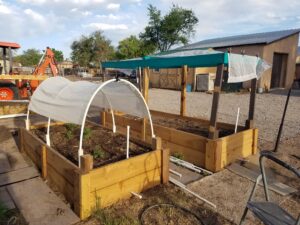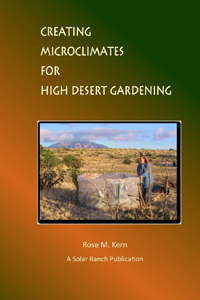Retired air traffic control specialist Rose Marie Kern is a New Mexico Master Gardener, a beekeeper, and a solar chef. She is a popular speaker at aviation events and also gives lectures on microclimatology for gardening groups across the Southwest. In addition to publishing five nonfiction books, Rose has written over 1,000 articles on topics ranging from solar energy and organic gardening to those focused on aviation. Her first book, The Solar Chef (2009), is in its seventh edition and is the most popular solar cookbook in the United States. Creating Microclimates for High Desert Gardening (2019) is her most recent release. Visit Rose on her websites at SolarRanch.com and RoseMarieKern.com. Read more about the author and her writing in her 2017 and 2019 interviews.
Who is your target audience for this book?
Gardeners. The kind of person who cringes when leaves get crinkly or limp and can hear the poor little things sobbing in distress.
What is a microclimate, and why is it important to high desert gardening?
First you have to understand what the climate of the region is and how it affects plants. Not just extreme temperature variations (such as New Mexico experiences) but air pressure at high altitudes, rainfall, and windflows. Then you can either take advantage of—or create—conditions in your yard that will enhance the plants’ abilities to flourish when temperatures climb to 100 degrees, 50 knot winds rip through, or monsoon hail threatens.
What was your greatest challenge in putting this project together and bringing it to publication?
Of the five books I’ve written, this was the easiest for me, because it combined my two lifelong occupations: gardening and the knowledge I gained from working as an aviation weather briefer. I have given lectures on the topic to Master Gardener programs in New Mexico and Arizona for the past 14 years. The biggest challenge was determining how much to include. I also traveled to other gardens in central and northern New Mexico and Arizona to gather photos and speak to those gardeners about how they tackle challenges.
 How did the book come together?
How did the book come together?
I have a large garden, and I like to experiment. I also incorporate elements of sustainable living techniques by creating garden beds from recycled materials. Photo documentation of all my gardens through the years provided a plethora of images for the book. Articles I’ve written have appeared in several venues: Mother Earth News (composting), the Master Gardener Newsletters, and on the Solar Ranch website.
You seem to have a knack for filling the gap in a niche market. What is your process for discovering your next writing project?
For some reason I can see when something is needed by a group or groups of people. My next nonfiction project is a historical look at the Flight Service division of Air Traffic Control which began in 1920 and now, 100 years later, is fading away. During its heyday it was the general aviation pilots’ most-valued service.
If time and money were not a concern, what one skill would you like to learn?
Fiction writing, stained glass, and pottery.
 What can nonfiction writers learn from fiction writers?
What can nonfiction writers learn from fiction writers?
Nonfiction requires that you create an outline of what you need to include—for me this is simple. My greatest difficulty in writing fiction is expanding beyond dry factual information. I so admire those who can weave a tapestry of words which ensnare a reader’s senses. This is what I need to work on.
What writing projects are you working on now?
Other than the nonfiction project already mentioned, I am attempting a novel—a murder mystery featuring a woman who investigates aircraft accidents.
 KL Wagoner (writing as Cate Macabe) is the author of This New Mountain: a memoir of AJ Jackson, private investigator, repossessor, and grandmother. Kathy posts to a speculative fiction blog at klwagoner.com and writes about memoir at ThisNewMountain.com.
KL Wagoner (writing as Cate Macabe) is the author of This New Mountain: a memoir of AJ Jackson, private investigator, repossessor, and grandmother. Kathy posts to a speculative fiction blog at klwagoner.com and writes about memoir at ThisNewMountain.com.



























Leave a Reply